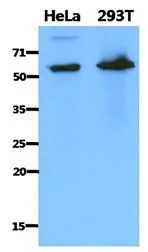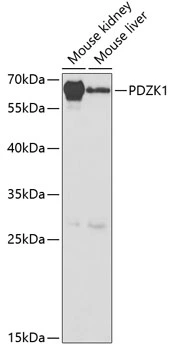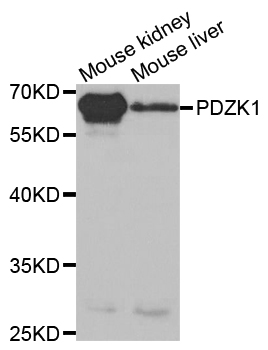
WB analysis of HeLa and 293T lysates (40ug per lane) using PDZK1 antibody at a dilution of 1:1,000.
PDZK1 antibody [AT1A2]
GTX53760
ApplicationsWestern Blot, ELISA
Product group Antibodies
TargetPDZK1
Overview
- SupplierGeneTex
- Product NamePDZK1 antibody [AT1A2]
- Delivery Days Customer9
- Application Supplier NoteThe antibody has been tested by ELISA, Western blot analysis to assure specificity and reactivity. Since application varies, however, each investigation should be titrated by the reagent to obtain optimal results. Recommended starting dilution is 1:1000.
- ApplicationsWestern Blot, ELISA
- CertificationResearch Use Only
- ClonalityMonoclonal
- Clone IDAT1A2
- Concentration1 mg/ml
- ConjugateUnconjugated
- Gene ID5174
- Target namePDZK1
- Target descriptionPDZ domain containing 1
- Target synonymsCAP70, CLAMP, NHERF-3, NHERF3, PDZD1, Na(+)/H(+) exchange regulatory cofactor NHE-RF3, CFTR-associated protein of 70 kDa, Na(+)/H(+) exchange regulatory cofactor 3, PDZ-containing kidney protein 1, na/Pi cotransporter C-terminal-associated protein 1, naPi-Cap1, sodium-hydrogen exchanger regulatory factor 3
- HostMouse
- IsotypeIgG2b
- Protein IDQ5T2W1
- Protein NameNa(+)/H(+) exchange regulatory cofactor NHE-RF3
- Scientific DescriptionThis gene encodes a PDZ domain-containing scaffolding protein. PDZ domain-containing molecules bind to and mediate the subcellular localization of target proteins. The encoded protein mediates the localization of cell surface proteins and plays a critical role in cholesterol metabolism by regulating the HDL receptor, scavenger receptor class B type 1. Single nucleotide polymorphisms in this gene may be associated with metabolic syndrome, and overexpression of this gene may play a role in drug resistance of multiple myeloma. Pseudogenes of this gene are located on the long arm of chromosome 1. Alternatively spliced transcript variants encoding multiple isoforms have been observed for this gene. [provided by RefSeq, Jan 2011]
- Storage Instruction-20°C or -80°C,2°C to 8°C
- UNSPSC12352203





